Most wines available on the market today are made from international varietals. From Sauvignon Blanc and Chardonnay, to Merlot and Cabernet Sauvignon, many of the world’s vineyards have been focused on the cultivation of these well-known grapes partly because they are universally familiar and satisfy global palates. However, Donnachiara vineyard in Montefalcone di Val Fortore, Campania believes in the importance of planting local varietals and crafting wines that highlight the distinctive traits and qualities that are exclusive to these traditional grapes. The 5 generation family-owned Italian vineyard occupies an ideal location for producing Fiano di Avellino, Greco di Tufo and Taurasi.

Ilaria Petito manages the vineyard with her mother Chiara. The vineyard is named for Ilaria’s grandmother. Ilaria decided to cultivate Falanghina at the vineyard along with these 3 traditional varietals. Donnachiara adheres to the guidelines established by the “Misura C.E. n 1257/99” “Produzione integrata della Regione Campania” and limits the use of chemicals while using environmentally conscious methods in the production of their wines whenever possible.
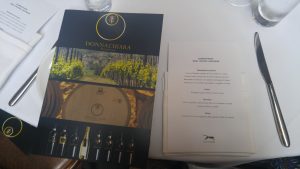
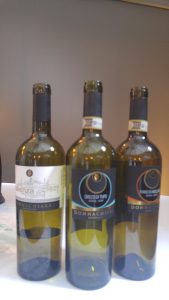
Donnachiara showcased the best of their 2016 harvest on October 13, 2017 beginning with 3 white varietals at Il Gattopardo in New York City A quartet of small bites: a crudo of raw sea bass marinated with lime and herbs, a country-style pizza topped with escarole, Gaeta olives and pecorino, a mozzarella-filled puff pastry flavored with an anchovy-based sauce and a rice ball with peas, parmesan and veal sauce, and an appetizer of Neapolitan-style long and flat square-shaped pasta topped with assorted seafood were paired with the 3 white wines.
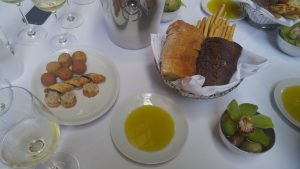
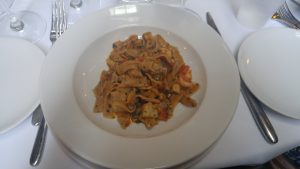

The first wine poured was a Beneventano Falanghina IGT, “Resilienza”, 2016, made from 100 percent Falanghina. Grapes for this wine were manually harvested during the coolest time of day. The grapes were then fermented in stainless steel. No malolactic fermentation was used in the production of this wine. The resulting vintage was soft and balanced with floral and white tea aromas. The wine had elegant notes of pear, ripe green apple and apricot, and fresh acidity, followed by a delicate and supple finish. This first vintage of Falanghina produced by Donnachiara emphasizes the floral and fruit-driven aspects of this fine varietal.
The second, a Fiano di Avellino D.O.C.G., 2016 comprised of 100 percent pressed and rapidly cooled Fiano grapes that did not undergo malolactic fermentation after being placed in steel vats for 15 days was crisp, and full of tropical fruit, nutty and subtle mineral notes. This wine can likely age well much like a Bourgogne.

The third, a Greco di Tufo D.O.C.G., 2016 consisted of 100 percent Greco. The grapes are gently crushed and cold decanting (of the must) occurs before it is fermented in steel vats for 15 days. It was lively and smooth with lush citrus and orchard fruit notes.
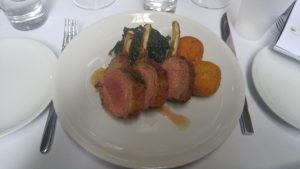
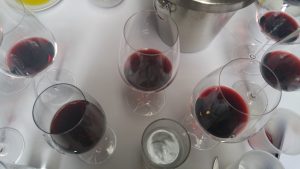
A loin of lamb croquette seasoned with herbs and served with sauteed potatoes and spinach, and a dessert of rum baba served with iced coffee and cream were chosen to complement 3 reds. These included an Irpinia Aglianico D.O.C., 2015 that was fermented in stainless steel tanks for 15 days before undergoing malolactic fermentation in 20 percent new oak barriques. Rich aromas of mocha and espresso, and notes of ripe plums, dark berries and chocolate, rounded out the inherent tannic quality of this grape.

An older 100 percent Aglianico vintage, a Taurasi D.O.C.G., 2013 underwent a production process where the must of the manually picked grapes was fermented in stainless steel tanks and allowed to mature on their skins for 15 days after the grapes were pressed. Malolactic fermentation was done in barriques. This full-bodied and powerful wine is rich with berry, plum and violet aromas. Notes of cherries, coffee, berries and dark chocolate persist in this structured and complex wine.

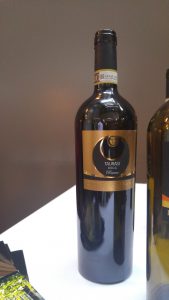
A Taurasi Riserva D.O.C.G., 2012 made with 100 percent select Aglianico that are manually harvested, soft pressed and left in contact with their skins for 20 days before undergoing malolactic fermentation in barriques was characterized by rich aromas of dark berries, violets and cherries. Notes of plum, ripe raspberries and coffee were also present. This refined wine shows good aging potential.

Be First to Comment